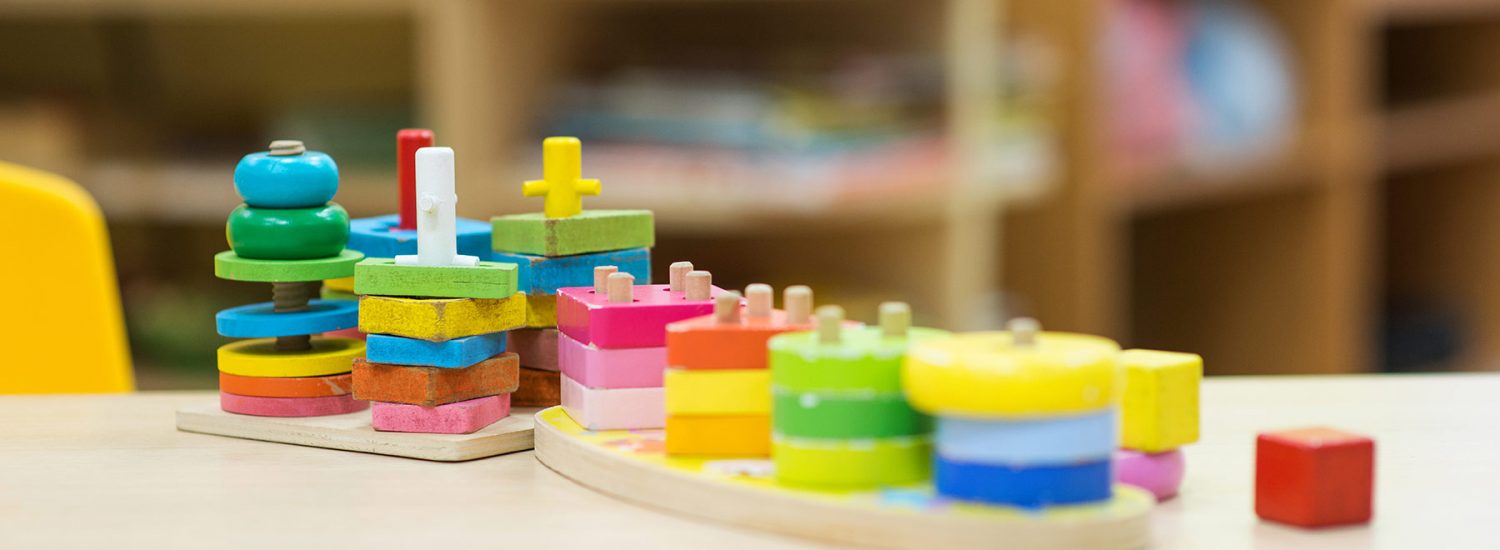Dr. Montessori believed that the goal of early childhood education should not be to fill the child with facts from a pre-selected course of studies, but rather to cultivate the child’s own natural desire to learn.
Practical Life Exercises
In this area of the classroom, children develop their coordination and motor skills while becoming absorbed in everyday activities. They become confident, independent, and gradually lengthen their span of concentration. They also learn to pay attention to details as they follow a regular sequence of actions. Finally, they learn good work habits as they finish each task and put materials away before beginning another activity.
Sensorial Exercises
A young child meets the world around him through the constant use of all his senses. Since he quite naturally uses all his powers of observation during these early years, Dr. Montessori felt that this was an ideal time to give the child equipment, which would sharpen his senses and enable him to understand the many impressions he receives through them. The sensorial materials in the classroom help children to distinguish, to categorize, and to relate new information to what they already know. Dr. Montessori believed that this process is the beginning of conscious knowledge. It is brought about by the intelligence working in a concentrated way on the impressions given by the senses.
Mathematics
Dr. Montessori demonstrated that if a child has access to mathematical equipment in his early year, he can easily and joyfully assimilate many facts and skills of arithmetic. She designed concrete materials to represent all types of quantities after she observed that the child who becomes interested in counting likes to touch or move the items as he enumerates them. Later, by combining this equipment, separating it, sharing it, counting it, and comparing it, he can demonstrate to himself the basic operations of arithmetic. This activity gives him the satisfaction of learning by discovery rather than by being told. Eventually he develops an early enthusiasm for the world of numbers.
Language
In a Montessori classroom, children learn the phonetic sounds of the letters before they learn the alphabetical names in a sequence. The phonetic sounds are given first because these are the sounds the children hear in words that they need to be able to read. The children first become aware of these phonetic sounds when the Directress introduces the consonants with sandpaper letters.
The individual presentation of language materials in a Montessori classroom allows the Directress to take advantage of each child’s greatest period of interest. Reading instruction begins on the day when the child wants to know what a word says, or when he shows an interest in using the sandpaper letters. Writing, or the construction of words with movable letters, nearly always precedes reading in a Montessori environment.
Gradually, the children learn the irregular words and words with two and three syllables, by doing reading exercises which offer variety rather than monotonous repetition. Also available in the Montessori classroom are many attractive books using a large number of phonetic words. Proceeding at their own pace, children are encouraged to read about things that interest them. The children’s interest in reading is never satisfied by monotony. Rather, it is cultivated as their most important key to future learning. They are encouraged to explore books for answers to their own questions, whether they are about frogs, rockets, stars, or fire engines.
In the Montessori classroom, children are introduced to grammar by games, which show them that nouns are the names of things, adjectives describe nouns and adverbs are action words. The activity becomes almost enjoyable.
Physical Geography
The large wooden puzzle maps are among the most popular activities in the classroom. At first, the children use the maps simply as puzzles. Gradually, they learn the names of the countries as well as information about climate and products. Children also learn the common land formations such as islands and peninsulas. The large wooden puzzle maps are among the most popular activities in the classroom
History
The Montessori program offers children a concrete presentation of history by letting them work with Time Lines. Time Lines are very long strips of paper, which can be unrolled and stretched along the floor of the classroom. The lines are marked off in segments, which represent consecutive periods of history.
Science & Nature
The child’s natural curiosity is stimulated through discovery projects and experiments, which help him to draw his own conclusions. The plant and animal kingdoms are studied in an orderly fashion to foster a love and appreciation for all living things.
Cultural Awareness
The children gain an awareness of the world around them by exploring other countries; their customs, food, music, climate, language, and animals. This helps to raise the children’s awareness about other people, and to gain an understanding and tolerance, and therefore compassion, for all people of the world.

